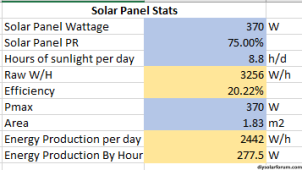Hi all,
I'm reasonably confident that some of this is right but I'm not sure if I have applied efficiencies in the right places, I was wondering if someone that is pretty good on both excel and their solar calcs can have a look at this for me.
It's a small system:
4 x 160A/H 12V Batteries
A 100|20 Victron MPPT
A 370W REC solar panel
It has a 30W load, constant calculated duty cycle over 24H but I want to know how far I can push it. I've attempted to make a calculator that gives me some feedback but I think I am tripping up over whether or not I should be applying the battery efficiency when I am recharging.
As in my total Efficient Battery W/h capacity with DOD is 3916.8
Should I just be applying the raw load / recharge rate to it (vastly oversimplified)
Or should I be applying the efficiency again for both removal and replacement of energy to my batteries? i.e. applying a multiplication factor of .85 to my daily MPPT output to determine what it can actually put back in?
I've attached my calculator if anyone cares to look. Hopefully it makes more sense then, it doesn't to me anymore, I've been looking at it too long...
Light blue cells are for data entry, light yellow are calculated
I do understand that this is a whole specialized field and I've probably missed a ton of concepts I don't even know I don't know but knowing I'm on the right track or how to get on the right track would be great!
TIA
Justin
I'm reasonably confident that some of this is right but I'm not sure if I have applied efficiencies in the right places, I was wondering if someone that is pretty good on both excel and their solar calcs can have a look at this for me.
It's a small system:
4 x 160A/H 12V Batteries
A 100|20 Victron MPPT
A 370W REC solar panel
It has a 30W load, constant calculated duty cycle over 24H but I want to know how far I can push it. I've attempted to make a calculator that gives me some feedback but I think I am tripping up over whether or not I should be applying the battery efficiency when I am recharging.
As in my total Efficient Battery W/h capacity with DOD is 3916.8
Should I just be applying the raw load / recharge rate to it (vastly oversimplified)
Or should I be applying the efficiency again for both removal and replacement of energy to my batteries? i.e. applying a multiplication factor of .85 to my daily MPPT output to determine what it can actually put back in?
I've attached my calculator if anyone cares to look. Hopefully it makes more sense then, it doesn't to me anymore, I've been looking at it too long...
Light blue cells are for data entry, light yellow are calculated
I do understand that this is a whole specialized field and I've probably missed a ton of concepts I don't even know I don't know but knowing I'm on the right track or how to get on the right track would be great!
TIA
Justin





